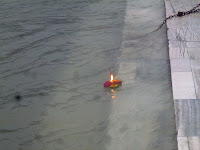 |
| the Ganges River ghats in Haridwar |
We start out for parts north, hoping to see The Ganges River and The Himalaya Mountains. We're sure the Ganges will be forthcoming. We aren't so confident of seeing even a peek of that massive mountain range, but we are going to give it our best try. It'd be better, obviously, if we had planned a few more days in the northernmost town Mussoorie, but we are now down to our last few days in India, and that's all we have left to devote to the trip north.
 |
| closeup of ghats |
The Ganges (Ganga, as they call it) rolls along at a pretty good speed as we stop in Haridwar to see the ghats. Ghats are very wide steps, almost seawall-like on the sides of the river that allow pilgrims to get down to the river to bathe. There are hundreds of people on the ghats and in the water; vendors are selling special rice, plastic jugs of sacred river water to take home, fruit and other foods to consume, flowers to float down the river with prayers, trinkets to buy, beggars asking for some small (or large) donation, and men from the temples collecting money. I give an orange to a little girl asking for money, and she appears surprised but pleased. It's a semi-carnival atmosphere. People are enjoying their families and friends and seem to be interested in us as we stroll along. We are taking photos of them, and they are doing the same of us.
 |
| wild elephants---would have been fun to see--we looked hard |
 |
| one of many ashrams in Rishikesh |
We drive on to Rishikesh of Beetles fame (they stayed here for a month or so) and pass by the area of wild elephants' crossing. We get a photo of warning signs, but, alas, no wild elephants. The weather is holding as we arrive in town and walk across the footbridge to visit a couple of ashrams and watch the
Ganga aarti, the river-worshipping ceremony from one of the ghats. The Hindu followers chant, sing, and play drums and cymbals as the crowd gathers. Little flickering candles in flower boats make their way into the river's fast flow; some stay lit and some burn out.
 |
| beginning the Ganga aarti |
 |
| many candles lit--some to be sent downriver |
 |
| catching the flow |
We move on up to Mussoorie the next day amid gathering clouds. We pass a beautiful Tibetan temple along the way then a sharp turn and a stunning view of a village built on the side of the mountain with terracing winding down from it. No rain yet, but clouds are swirling. Another hour and we emerge from the curving road into the town---just as heavy rains begin. We check into our hotel and immediately look for the mountain range. Too late.
 |
| Tibetan temple |
 |
| terraced land |
We walk through town in the deluge to find the Tibetan Market, but the Tibetans are smarter than we are--they have stayed home, so the market is not going to be part of our sightseeing tour. Soaked to the skin, we spot a coffee shop and stop in to regroup and make a Plan B. As it turns out, Plan B is staying in our hotel room and watching the clouds and rain obscure not only the far mountains, but the closer foothills and even other parts of the town.
 |
| 2 monkeys trying to stay dry on the balcony |
We are trying to dry our clothes and shoes in front of a small heater in the room of our hotel which is British-built (1840), maharajah-renovated and has a beautiful view if the clouds and rain were not obstructing it. As it is, we can't see the terraced valley we drove by on our way in, the Himalayan peaks above us, or the town of Dehra Dun 5000 feet below us. Our room is freezing,but I am under the covers,except for my hands, typing this blog, and we are ever-hopeful of clearing in the morning.
 |
| our room could have a beautiful view |
No clearing, just more rain. In fact, a thunder and lightning storm arrives in the night. We awake several times to find the electricity off. The weather report says no clearing until Thursday, and by then we will be flying to London. So, too bad, we will just have to return to see the Himalayas another day.























































